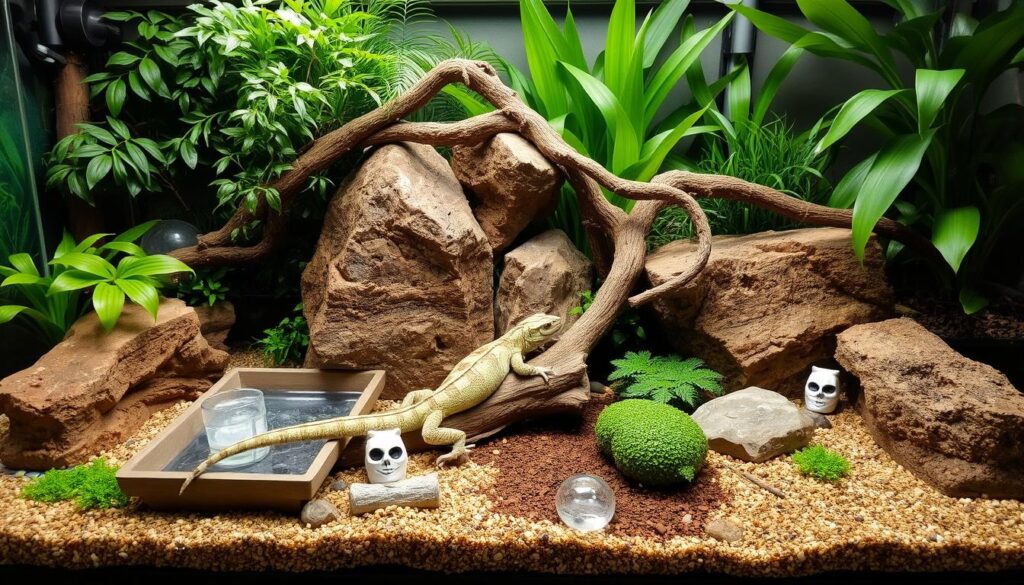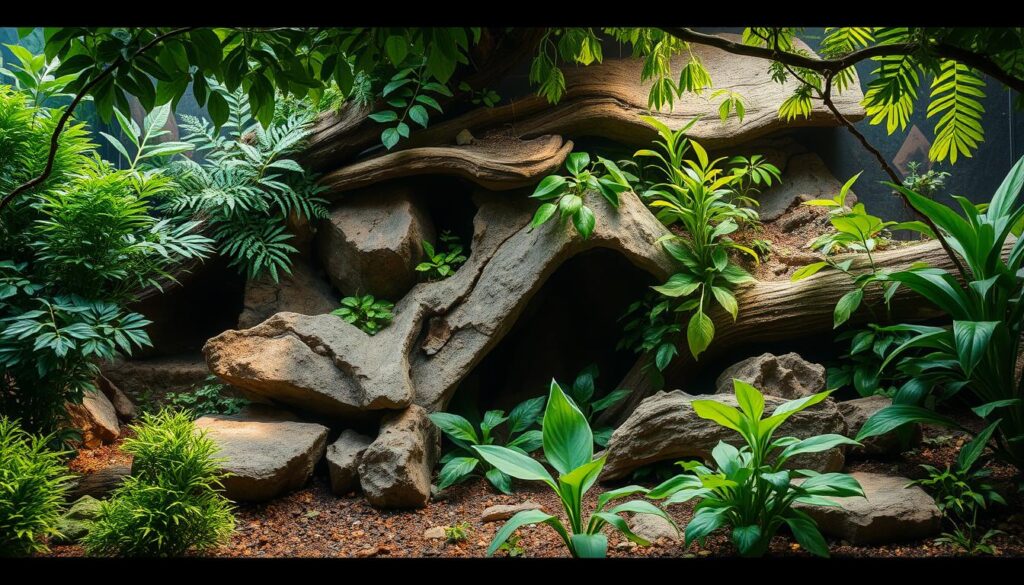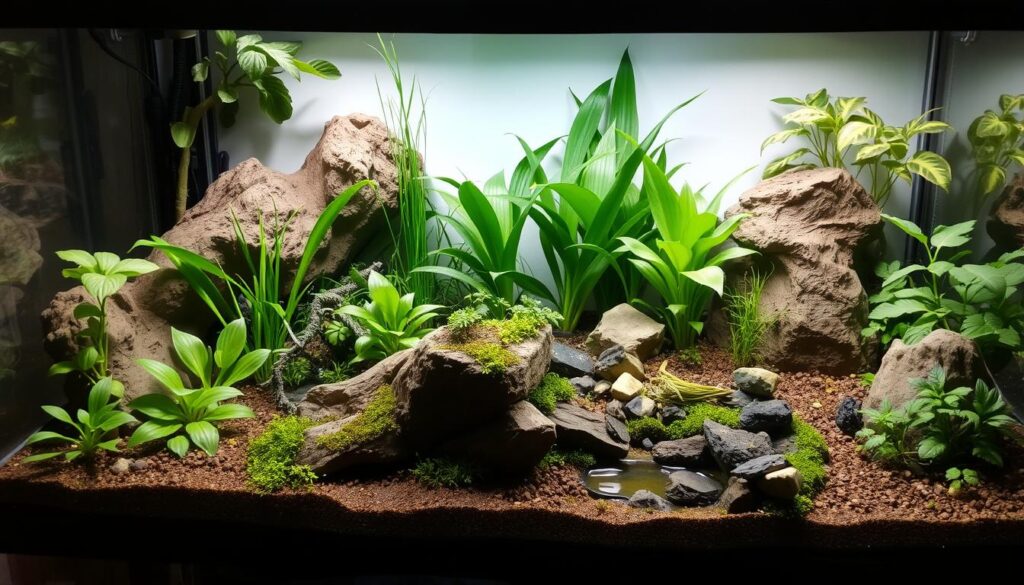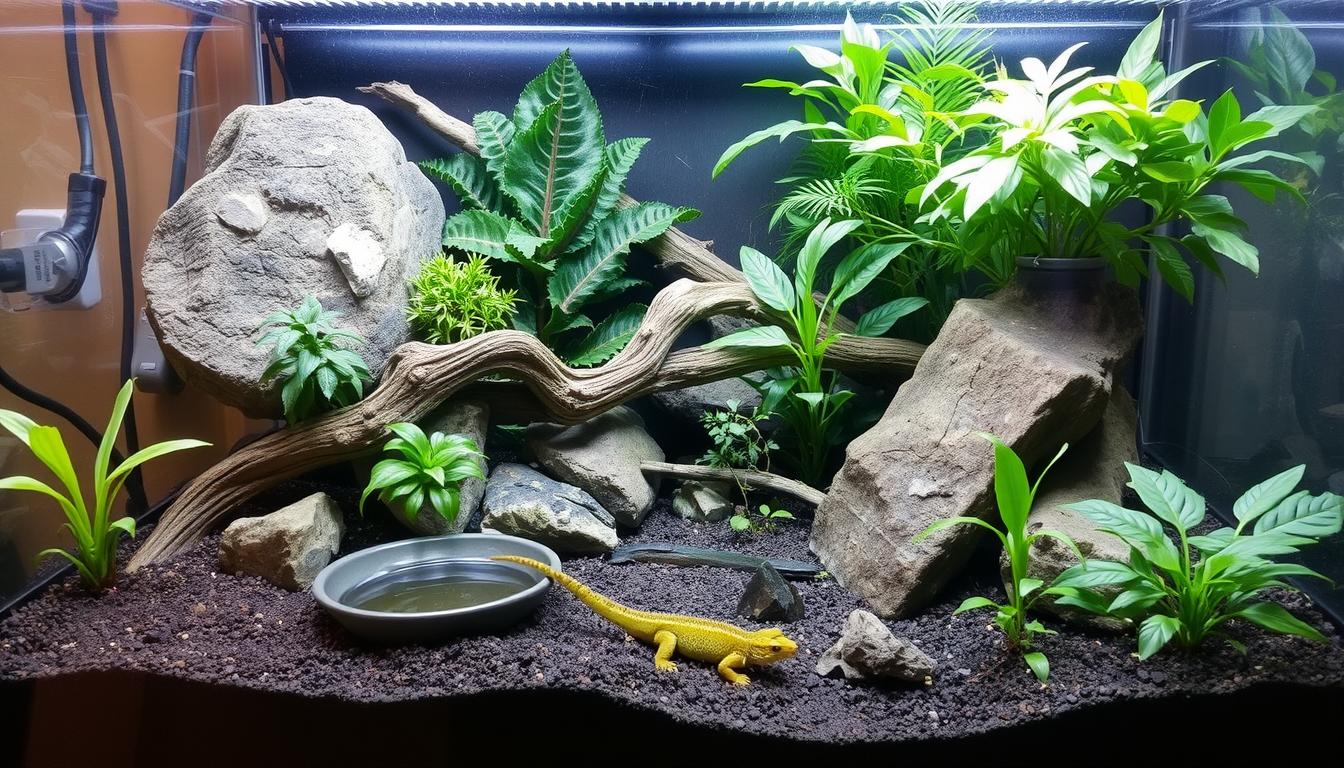A well-set up reptile habitat is key for your pet’s health. A reptile care guide offers important tips. By creating a habitat that mirrors their natural home, your reptile will thrive. This guide will show you how to set up a great habitat for your reptile.
Introduction to Reptile Care
Knowing how to design a good habitat is vital for your reptile’s happiness. A reptile habitat setup guide can help you create the perfect environment. By following care instructions, you can ensure your reptile stays healthy and happy.
Key Takeaways
- A properly set up reptile habitat is essential for your pet’s health and well-being.
- A comprehensive reptile habitat setup guide can provide valuable reptile care instructions.
- Understanding your reptile’s natural environment is crucial for creating a suitable habitat.
- A well-designed habitat can help prevent health problems and ensure a long and happy life for your pet.
- Following a reptile care guide can help you create a habitat that meets your pet’s specific needs.
- A reptile habitat setup guide can help you maintain your pet’s habitat and ensure a healthy environment.
Understanding Your Reptile’s Natural Environment
Setting up a reptile habitat means knowing your pet’s natural home. You need to learn about their temperature, humidity, and lighting needs. For instance, desert animals like high heat and low moisture. Tropical ones need more moisture.
To start, check out this reptile habitat setup guide for tips. By using the best enclosure advice, you’ll keep your reptile happy and healthy.
Desert Species Requirements
Desert animals, like bearded dragons and leopard geckos, love dry, hot places. Their homes should be between 75-90°F, with a spot up to 100°F for basking. Keep the humidity low, around 30-50%.
Tropical Species Needs
Tropical animals, such as iguanas and anoles, prefer humid, warm spots. Their homes should be 75-85°F, with humidity at 60-80%.
Temperature and Humidity Zones
It’s key to create different temperature and humidity areas in the enclosure. Use heat lamps or mats for warmth. For moisture, add sphagnum moss or coconut fiber.
Essential Equipment for Your Reptile Habitat Setup Guide
Creating a good home for your reptile is key. You need the right equipment for a reptile terrarium or tank. This includes the enclosure size, heating and lighting, and substrate. The right gear makes sure your pet’s home is safe and healthy.
For your reptile terrarium, you’ll need a top-notch terrarium or tank. A heat source like a heat lamp or ceramic heat emitter is also important. Don’t forget a UVB light for UVB rays. You’ll also need substrate, like reptile carpet or sand, and decorations like rocks and plants.
- Choose a tank that is large enough for your reptile to move around comfortably
- Select a heating source that is suitable for your reptile’s specific needs
- Use a UVB light to provide essential UVB rays
By following these tips and choosing the right equipment, you can make a happy and healthy home for your reptile.
Choosing the Right Enclosure Size
When setting up a reptile habitat, picking the right enclosure size is key. The size should give enough room for movement and can house several reptiles. However, it also means higher costs and more space needed. It’s important to design the habitat with the reptile’s needs and growth in mind for a healthy home.
A bigger enclosure means more room for your reptile to move around. This is vital for reptiles that need to exercise to stay fit. But, remember to think about how big your reptile will get. For instance, a ball python can grow up to 5 feet long. So, you’ll need a bigger space for it to be comfortable.
Size Requirements by Species
- Find out how big your reptile will get and how fast it will grow to know the minimum size needed.
- Think about how active your reptile is and how much it needs to move when picking a size.
- Make sure the enclosure is big enough for your reptile to turn, stretch, and move easily.
By keeping these points in mind and using good design ideas, you can make a great home for your reptile. Always put your reptile’s needs and growth first when choosing a size. This way, your pet will be happy and healthy.
Substrate Selection and Installation
Choosing the right substrate is key for a good reptile enclosure setup. The substrate is the material at the bottom of the enclosure. It can be sand, wood shavings, or reptile carpet. The right choice depends on the reptile species and how easy it is to clean.
Some substrates, like sand, can cause breathing problems in certain reptiles. So, picking the right one is very important.
When picking a substrate, consider these factors:
- Species requirements: Find out what your reptile needs for the best substrate.
- Ease of cleaning: Pick a substrate that’s easy to clean to avoid bacteria and odors.
- Moisture levels: Choose a substrate that can handle the moisture in your enclosure. Some substrates can absorb too much moisture and cause breathing issues.
Installing the substrate correctly is also part of a proper setup. Make sure the layer is deep enough for digging and burrowing. Also, spread the substrate evenly across the enclosure. This way, you create a healthy space for your reptile.

Remember, a good reptile enclosure setup is vital for your pet’s health. By picking the right substrate and installing it right, you make a safe and thriving home for your reptile.
Creating Temperature Gradients
Setting up a reptile habitat means creating temperature gradients. This is key for your pet’s health. It lets them move between warm and cool spots to control their body temperature. This is important for their metabolism, digestion, and health.
Guides often suggest using heat lamps or ceramic heat emitters. These tools help make the temperature gradients. But, it’s important to use them right to avoid too much or too little heat. For example, a basking spot can be around 95°F (35°C) with a heat lamp. A cooler area, about 75°F (24°C), can be made with a heat mat or ceramic heat emitter.
Heating Equipment Options
There are many heating options like heat lamps, ceramic heat emitters, and heat mats. Each has its own benefits and drawbacks. The right choice depends on your reptile’s needs and the enclosure’s design. It’s important to research and understand these options well.
Basking Spot Setup
A basking spot is vital for your reptile’s health. It’s where they can warm up and regulate their body temperature. When setting up a basking spot, think about the temperature, lighting, and humidity. A well-designed spot helps create a natural and healthy environment for your pet.
Night Temperature Management
Managing night temperatures is also important. Many reptiles need a cooler temperature at night. This can be done with a thermostat or a temperature-controlled heating system. By following a setup guide and knowing your pet’s needs, you can create a healthy environment.
Lighting Systems and UVB Requirements
Setting up a reptile habitat means thinking about lighting systems and UVB needs. Reptile care guides stress the importance of the right lighting. It’s key for their health, especially UVB for calcium and bone health.
Experts say the lighting type and intensity vary by species. Some need strong UVB, others less. Knowing your reptile’s needs is crucial for a good environment.
When picking lighting, consider these points:
- UVB output: Make sure it matches your reptile’s needs.
- Intensity: Choose something adjustable for your reptile’s comfort.
- Spectrum: Look for a light that mimics natural sunlight, including UVB and UVA.
By following care tips and setting up the right lighting, you help your reptile stay healthy. Always research your reptile’s specific needs for the best care.
Humidity Control and Ventilation
Keeping the right humidity is key for your reptile’s health. A good reptile terrarium should control humidity and have good air flow. Use misting systems for humidity and ventilation systems for air flow to prevent bacteria and fungi.
When setting up your reptile enclosure, think about the best tips. Use a hygrometer to check humidity levels. This keeps your reptile safe from too dry or too wet conditions.
Misting Systems
Misting systems help increase humidity in your reptile’s home. You can choose between automated or manual systems. Automated systems mist at set times for consistent humidity.
Humidity Monitoring Tools
Tools like hygrometers are vital for the right humidity. They let you track humidity and adjust as needed. This keeps your reptile’s environment healthy.
Air Flow Management
Managing air flow is crucial to stop bacteria and fungi. Good ventilation removes stale air and brings in fresh. Follow the best tips and use a well-designed terrarium for a healthy reptile home.
Designing Natural Hiding Spots
Creating the perfect reptile habitat needs careful attention to detail. This includes making natural hiding spots that feel like their natural home. These spots help reduce stress by giving reptiles a sense of safety and comfort. It’s important to have different hiding spots, like rocks, plants, or special hiding places, to meet their instinct to hide.
Think about the reptile’s species and where it comes from when designing hiding spots. For example, desert reptiles need spots that look like rocks or sand. Tropical reptiles need spots that look like plants or trees. This way, you make a habitat that looks good and works well, helping to create the perfect reptile home.

- Use a variety of materials, such as wood, rock, or plants, to create hiding spots that are visually appealing and functional.
- Incorporate different textures and colors to create a natural and immersive environment.
- Place hiding spots strategically throughout the enclosure to provide the reptile with multiple options for concealment.
By following these tips and using reptile habitat design ideas, you can make a habitat that meets their physical and emotional needs. This will help create the perfect reptile habitat.
Water Features and Hydration Sources
When it comes to reptile tank setup tips, clean water is key for your reptile’s health. A good water feature helps keep humidity up and encourages drinking. For a proper reptile enclosure setup, think about these points.
Some important things to consider for water features and hydration sources are:
- Water bowl placement: Put water bowls where they won’t grow bacteria and are easy for your reptile to reach.
- Filtering systems: Use a filter to keep the water clean and free of bacteria.
- Cleaning protocols: Clean regularly to stop bacteria growth and keep the water quality good.
Water Bowl Placement and Filtering Systems
By following these reptile tank setup tips and thinking about proper reptile enclosure setup, you can make a healthy home for your reptile. Always do your research to meet your reptile’s specific needs for the best care.
Creating Climbing and Exercise Areas
Setting up a reptile habitat is all about meeting your pet’s physical and mental needs. Many reptiles love to climb and exercise. A good guide will suggest using rocks, branches, or climbing walls for this.
A good habitat setup guide should have different climbing spots for various reptiles. Some like to climb up, while others prefer to crawl along. Mixing walls, rocks, and branches makes a fun and active space for your reptile.
When setting up climbing and exercise areas, keep these tips in mind:
- Stability and safety: Make sure climbing spots are stable and won’t fall over, harming your pet.
- Variety: Provide different climbing surfaces and textures to keep your reptile interested.
- Accessibility: Ensure climbing areas are easy to reach without straining your reptile.
By following a reptile housing guide and adding climbing spots, you’ll make your pet happy and healthy. Always research what your reptile needs to give them the best care.
Safety Measures and Escape Prevention
Setting up a reptile habitat safely is key for both the reptile and the owner. Reptile care guides stress the need for a secure space to avoid escapes and injuries. Making sure the enclosure is escape-proof is crucial. This can be done by following care instructions and taking the right steps when setting up the habitat.
Choosing secure lids is a big part of keeping reptiles from escaping. Options include locking mechanisms or weighted lids that reptiles can’t open. Also, it’s important to seal any gaps or holes in the enclosure. Even small openings can be a way out. By following these steps, owners can prevent accidents and keep their reptiles safe and healthy.
Secure Lid Options
- Locking mechanisms to prevent reptiles from pushing the lid open
- Weighted lids that are difficult for reptiles to move
- Escape-proof clips and fasteners to secure the lid in place
Gap Prevention
It’s important to check the enclosure for gaps or holes regularly. Look for any openings around the lid, vents, or other features. Finding and fixing these escape routes helps keep the reptile safe and secure.
Emergency Protocols
Having a plan for emergencies is crucial. This includes knowing how to safely catch the reptile and having a secure, temporary enclosure. Being prepared helps avoid injuries to both the reptile and the owner.
Plant Selection for Bioactive Setups
Choosing the right plants is key for a thriving bioactive setup for your reptile. The right plants help keep the ecosystem balanced, clean the air, and feed beneficial microorganisms. Look for plants that are safe for your reptile and fit well in the habitat.
A good reptile terrarium setup includes a mix of plants. Ferns, mosses, and air plants are great choices. They look good and help keep humidity and temperature right.
When picking plants, think about a few things:
- Lighting needs: Pick plants that do well with your reptile’s enclosure light.
- Temperature: Choose plants that like the temperature in your reptile’s home.
- Humidity: Select plants that handle the humidity in your reptile’s space.
By following these tips, you can make a bioactive setup that’s healthy and fun for your reptile. Make sure to pick plants that are safe and fit the habitat’s needs.

Monitoring Equipment Installation
Creating the perfect reptile habitat means installing monitoring equipment. This is key to keeping the right temperature and humidity. It’s vital for your pet’s health and well-being.
Accurate readings from thermometers and hygrometers help you adjust the habitat as needed.
To get this right, consider these important points:
- Thermometer placement: Put thermometers near the basking spot and in the coolest area. This gives you accurate temperature readings.
- Hygrometer setup: Place hygrometers in areas with changing humidity, like near water or where evaporation is high.
Correctly installing monitoring equipment helps create a stable, healthy environment for your reptile. It’s a crucial part of making the perfect reptile habitat. Always check and calibrate your equipment to keep it accurate and make any needed adjustments.
With the right monitoring equipment, you’ll have a thriving environment for your reptile. Your hard work in creating the perfect habitat will be worth it.
Common Setup Mistakes to Avoid
Setting up a reptile enclosure can be tricky. Knowing common mistakes helps keep your reptile healthy. A good guide can steer you clear of these issues, making a safe space for your pet.
One big mistake is wrong temperature levels. This can stress and make your reptile sick. Another error is not enough light, which messes with their body temperature and metabolism.
Also, bad ventilation can cause breathing problems. To avoid these, learn what your reptile needs and plan your setup carefully.
Some important things to remember are:
- Creating a temperature range that fits your reptile’s needs
- Using enough light, including UVB, to help with calcium and bone health
- Ensuring good air flow to keep your reptile’s environment healthy
By following a detailed guide and watching out for these mistakes, you can make a great home for your reptile. A well-set-up enclosure is key to your pet’s health and happiness.
Daily Maintenance and Habitat Upkeep
Proper care is key for a healthy reptile home. Setting up a habitat is just the start. Daily upkeep is vital for your pet’s health. A clean home means less disease and stress, leading to a happy life for your reptile.
Creating a cleaning schedule is important. It means removing waste, cleaning bowls, and changing substrate when needed. A regular cleaning routine stops bacteria and odors, keeping your reptile’s home fresh.
Cleaning Schedule
- Daily: Remove feces and uneaten food, clean water and food bowls
- Weekly: Replace substrate, clean decorations and accessories
- Monthly: Deep clean the entire habitat, including filters and pumps
It’s also crucial to check your equipment often. Make sure temperature and humidity are right. Check for wear or damage too. By following these steps, you’ll create a safe, healthy space for your reptile.
Making Your Reptile’s Home Perfect: Final Tips and Recommendations
Creating the perfect home for your reptile is a journey. It needs dedication, attention to detail, and a willingness to change. By following this guide, you can make sure your reptile’s home meets its needs. This will help keep it healthy and happy.
When you’re done setting up your reptile’s home, keep an eye on how it behaves. Make changes if needed. Keep the temperature, humidity, and lighting right. Also, be quick to fix any problems that come up.
If you have questions or face challenges, don’t be shy. Talk to reptile experts, vets, or check online resources. With the right effort, you can make a great home for your reptile. It will be safe, comfy, and full of life.
FAQ
What are the key considerations for setting up a reptile habitat?
When setting up a reptile habitat, it’s important to know the reptile’s natural environment. You should choose the right enclosure size and substrate. Also, create temperature gradients, provide proper lighting, and maintain humidity levels.
Designing natural hiding spots is also key. This helps reduce stress and keeps your reptile happy and healthy.
How do I determine the right enclosure size for my reptile?
The enclosure size depends on the reptile’s species and growth rate. It should give enough space for the reptile to move. If you plan to keep multiple reptiles, remember to account for their space needs.
What type of substrate is best for a reptile habitat?
The best substrate depends on the reptile’s species and how easy it is to clean. Options include sand, wood shavings, and reptile carpet. Avoid substrates that can cause respiratory problems in certain reptiles.
How do I create proper temperature gradients in the habitat?
Temperature gradients help reptiles regulate their body temperature. Use heating equipment like heat lamps or ceramic heat emitters. This creates a basking spot and cooler areas in the habitat.
What kind of lighting system does my reptile need?
Lighting is crucial for reptiles’ metabolic processes. UVB lighting is especially important for calcium metabolism and preventing metabolic bone disease. The lighting needs vary by species, so research your reptile’s specific needs.
How do I maintain the right humidity levels in the habitat?
Keeping the right humidity levels is vital for your reptile’s health. Use misting systems and proper ventilation. Monitor humidity levels with tools like hygrometers.
Why are hiding spots important in a reptile habitat?
Hiding spots reduce stress in reptiles. Use rocks, plants, or commercial hiding places. These mimic the reptile’s natural environment, providing security and comfort.
How do I ensure the habitat is escape-proof?
Make sure the enclosure has a tight-fitting lid and no gaps. This keeps the reptile safe and prevents escapes. Have emergency plans ready in case of an escape.
What are some common setup mistakes to avoid when creating a reptile habitat?
Avoid common mistakes like incorrect temperature gradients and inadequate lighting. Also, ensure proper ventilation and use the right substrates. Knowing these pitfalls helps create a safe environment for your reptile.
How often should I maintain and clean the reptile habitat?
Daily maintenance is crucial for your reptile’s health. This includes regular cleaning, checking equipment, and replenishing supplies. It helps prevent disease and stress.

